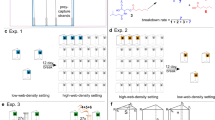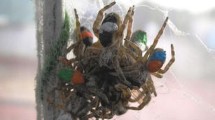Abstract
Animals create extended phenotypes to adaptively modify and interact with their environment. Animals also respond to changes in the environment by adaptively modifying their behavior or body in a process called phenotypic plasticity. Extended phenotypes might be especially prone to plasticity as they are often the products of behavior. We tested for plasticity in black widow web architecture in response to long-term variation in prey capture location. We also estimated genetic variation, genetic variation in plasticity, and sexual dimorphism in web architecture. We found no overall plasticity in response to variation in prey capture location. However, web architecture differed between spider families, and spider families differed in their plastic response. Web architecture also differed between male and female spiders, and male and female spiders differed in their plastic response. We conclude that black widows do not adjust web architecture in response to long-term inputs from the external environment and that internal inputs are responsible for more of the variation in web architecture than external inputs. We suggest that in order to fully understand variation in extended phenotypes, it is important to investigate potential environmental and physiological or genetic sources of variation, and to examine these potential sources at different time scales.
Significance statement
Animals can alter their extended phenotypes in response to short- or long-term variation in the external environment, or to internal sources of variation, such as genetic variation or sexual dimorphism. Studies asking how extended phenotypes vary at more than one time scale and that simultaneously test for variation due to different sources of variation are rare. Here, we ask how an extended phenotype varies in response to environmental variation at short and long time scales, whether the extended phenotype has a genetic component of variation, and whether the extended phenotype is sexually dimorphic. We found that the extended phenotype did not respond to long-term environmental variation but did differ in response to all tested internal inputs. These results suggest that variation in extended phenotypes should be considered at multiple time scales and across external and internal sources of variation.




Similar content being viewed by others
References
Bailey N (2012) Evolutionary models of extended phenotypes. Trends Ecol Evol 27:561–569
Barton K (2019) MuMIn: Multi-model inference. R package version 1(43):15 https://CRAN.R-project.org/package=MuMIn
Bates D, Maechler M, Bolker B, Walker S (2015) Fitting linear mixed-effects models using lme4. J Stat Softw 67:1–48
Benjamin SP, Zschokke S (2003) Webs of theridiid spiders: construction, structure, and evolution. Biol J Linn Soc 78:293–305
Blackledge TA, Zevenbergen JM (2007) Condition-dependent web architecture in the western black widow, Latrodectus hesperus. Anim Behav 73:855–864
Blamires SJ (2010) Plasticity in extended phenotypes: orb web architectural responses to variations in prey parameters. J Exp Biol 213:3207–3212
Blamires SJ (2013) Plasticity in extended phenotypes: orb web architectural responses to variations in prey parameters. J Exp Biol 213:3207–3212
Blamires SJ, Chao I-C, Tso I-M (2010) Prey type, vibrations and handling interactively influence spider silk expression. J Exp Biol 213:3906–3910
Blamires SJ, Martens PJ, Kasumovic MM (2018) Fitness consequences of plasticity in an extended phenotype. J Exp Biol:221
Dawkins R (1982) The extended phenotype. Oxford University Press, Oxford
DiRienzo N, Aonuma H (2018) Plasticity in extended phenotype increases offspring defense despite individual variation in web structure and behaviour. Anim Behav 138:9–17
DiRienzo N, Montiglio P-O (2016a) The contribution of developmental experience vs. condition to life history, trait variation and individual differences. J Anim Ecol 85:915–926
DiRienzo N, Montiglio P-O (2016b) Linking consistent individual differences in web structure and behavior in black widow spiders. Behav Ecol 27:1424–1431
Eberhard WG, Barantes G, Madrigal-Breners R (2008) Vestiges of an orb-weaving ancestor? The “biogenetic law” and ontogenetic changes in the webs and building behavior of the black widow spider Latrodectus geometricus (Araneae Theridiidae). Ethol Ecol Evol 20:211–244
Enders F (1975) The influence of hunting manner on prey size, particularly in spiders with long attack distances (Araneidae, Linyphiidae, and Salticidae). Am Nat 109:737–763
Flatt T (2005) The evolutionary genetics of canalization. Q Rev Biol 80:287–316
Ghalambor CK, McKAy JK, Carrol SP, Reznick DN (2007) Adaptive versus non-adaptive phenotypic plasticity and the potential for contemporary adaptation in new environments. Funct Ecol 21:394–407
Gregoric M, Kiesbuy HC, Quinones Lebron SG, Rozman A, Agnarsson KM (2013) Optimal foraging, not biogenetic law, predicts spider orb web allometry. Naturwissenschaften 100:263–268
Hill PSM, Wells H, Shadley JR (2006) Singing from a constructed burrow: why vary the shape of the burrow mouth? J Orthop Res 15:23–19
Johnson JC, Kitchen K, Andrade MCB (2011) Family affects sibling cannibalism in the black widow spider, Latrodectus hesperus. Ethol 116:770–777
Kasumovic MM, Andrade MCB (2004) Discrimination of airborne pheromones by mate-searching male western black widow spiders (Latrodectus hesperus): species- and population-specific responses. Can J Zool 82:1027–1034
Kuznetsova A, Brockhoff PB, Christensen RHB, Jensen SP (2017) lmerTest package: tests in linear mixed effects models. J Stat Softw 82:1–26
Lynch M, Walsh B (1998) Genetics and analysis of quantitative traits. Sinauer Associates Inc., Sunderland
Makowski D, Luedecke D, Ben-Shachar MS, Kelley K, Stanley D (2019) Effect size: compute and interpret indices of effect size. https://github.com/easystats/effectsize
Mhatre M, Bertram S (2018) Tree cricket baffles are manufactured tools. Ethol 124:691–693
Minter NJ, Franks NR, Robson Brown KA (2012) Morphogenesis of an extended phenotype: four-dimensional ant nest architecture. J R Soc Interface 9:586–595
Nakata K (2012) Plasticity in an extended phenotype and reversed up-down asymmetry of spider orb webs. Anim Behav 83:821–826
Nussey DH, Wilson AJ, Brommer JE (2007) The evolutionary ecology of individual phenotypic plasticity in wild populations. J Evol Biol 20:831–844
Perampaladas K, Stoltz JA, Andrade MCB (2008) Mated redback spiders re-advertise receptivity months after mating. Ethol 114:589–598
Quade FSC, Holtzheimer J, Frohn J, Toepperwien M, Salditt T, Prpic N-M (2019) Formation and development of the male copulatory organ in the spider Parasteatoda tepidariorum involves a metamorphosis-like process. Sci Rep 9:6945
R Core Team (2018) R: a language and environment for statistical computing. Vienna
Salomon M (2011) The natural diet of a polyphagous predator, Latrodectus hesperus (Araneae: Theridiidae) over one year. J Arachnol 39:154–160
Schaedelin FC, Taborsky M (2009) Extended phenotypes as signals. Biol Rev 84:293–313
Schneider JM, Vollrath F (1998) The effect of prey type on the geometry of the capture web of Araneus diadematus. Naturwissenshcaften 85:391–394
Sherman PM (1994) The orb-web: an energetic and behavioural estimator of a spider’s dynamic foraging and reproductive strategies. Anim Behav 48:19–34
Snell-Rood EC (2013) An overview of the evolutionary causes and consequences of behavioural plasticity. Anim Behav 85:1004–1011
Stoltz JA, McNeil JN, Andrade MCB (2007) Males assess chemical signals to discriminate just-mated females from virgins in redback spiders. Anim Behav 74:1669–1674
Thompson C, Rodriguez RL, Sergi C (2020) Repeatability but no short-term plasticity in the web architecture of Latrodectus hesperus western black widow spiders. Ethol:126
West-Eberhard MJ (2003) Developmental plasticity and evolution. Oxford University Press, Oxford
West-Eberhard MJ (2005) Developmental plasticity and the origin of species differences. Proc Natl Acad Sci 102:6543–6549
Zevenbergen JM, Schneider NK, Blackledge TA (2008) Fine dining or fortress? Functional shifts in spider web architecture by the western black widow Latrodectus hesperus. Anim Behav 76:823–829
Acknowledgments
We thank our Behavioral and Molecular Ecology colleagues at UWM, particularly Gerlinde Höbel, Peter Dunn, Linda Wittingham, and Felipe Alberto, for constructive comments on the design of our experiment and presentation of results.
Funding
We extend many thanks to the Animal Behavior Society for their generous funding of this experiment through a Student Research Grant awarded to CS.
Author information
Authors and Affiliations
Corresponding author
Additional information
Communicated by J. Pruitt
Publisher’s note
Springer Nature remains neutral with regard to jurisdictional claims in published maps and institutional affiliations.
Electronic supplementary material
ESM 1
(TXT 7 kb)
Rights and permissions
About this article
Cite this article
Sergi, C., Thompson, C., Montgomery, B. et al. The web architecture of Latrodectus hesperus black widow spiders (Araneae: Theridiidae) shows genetic variation and sexual dimorphism, but no plasticity according to the experience of the site of prey capture. Behav Ecol Sociobiol 74, 85 (2020). https://doi.org/10.1007/s00265-020-02867-4
Received:
Revised:
Accepted:
Published:
DOI: https://doi.org/10.1007/s00265-020-02867-4




